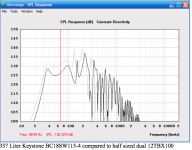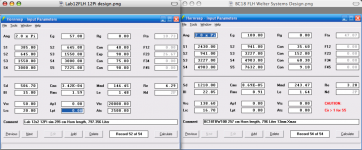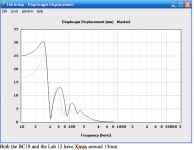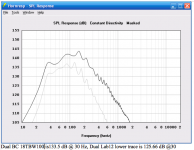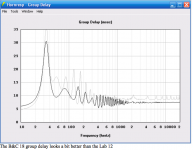How many subs are you looking to build? What size is the average room? Do you have enough power and amplifiers available to you? A power strip and one outlet isn't gonna cut it when you start talking those levels
An externally hosted image should be here but it was not working when we last tested it.
One sub preferably, two possibly. I was thinking around the size of a single lab horn, except I don't want to have to have 6 of them for good low output (I realize this compromises total output power)
Also I don't want to spend over about $3-400 on the woofer
About gym size would be the largest probably.
I was thinking somewhere between 1-2 kW amp. My friend just bought a one kilowatt ported sub so that leads me to believe he can handle the power
Mainly what I want to know is how the rated output measured at one meter will compare to the output at farther distances like at a venue
Also I don't want to spend over about $3-400 on the woofer
About gym size would be the largest probably.
I was thinking somewhere between 1-2 kW amp. My friend just bought a one kilowatt ported sub so that leads me to believe he can handle the power
Mainly what I want to know is how the rated output measured at one meter will compare to the output at farther distances like at a venue
This is only a rough example as Akabak models as a 2Pi environment (as outdoors, no walls around). There several good designs here. This driver B&C 18TBW100 has allot of potential! It all depends on exactly what your goals are
1 Meter - 3.3'
2 Meters - 6.6'
4 Meters - 9.9'
8 Meters - 26.4'
16 Meters - 52.8'
32 Meters - 105.6'
1 Meter - 3.3'
An externally hosted image should be here but it was not working when we last tested it.
2 Meters - 6.6'
An externally hosted image should be here but it was not working when we last tested it.
4 Meters - 9.9'
An externally hosted image should be here but it was not working when we last tested it.
8 Meters - 26.4'
An externally hosted image should be here but it was not working when we last tested it.
16 Meters - 52.8'
An externally hosted image should be here but it was not working when we last tested it.
32 Meters - 105.6'
An externally hosted image should be here but it was not working when we last tested it.
Outdoors, the inverse distance law (6 dB loss per doubling of distance) applies, indoors room modes cause interference patterns resulting in a wide disparity in level vs frequency and listening position.Ok thank you. So it goes down 6db every time distance doubles.
Ive been looking into the 12pi subwoofer and I really like that design, amd the drivers are cheap, even with the heatsinks from Wayne its not too bad
Using multiple subs in different locations can often help overcome the level disparity.
Using both sides of the speaker as two virtual drivers, tapped horns (TH) have a remarkable size (and weight) advantage over traditional front loaded horns (FLH) like the 12Pi.
The Hornresp simulation program used for comparison slightly exaggerates peaks and dips, the response of both the TH and FLH are actually smoother than the simulations suggest.
Comparing the output of a 337 liter single B&C loaded TH it is easy to see that a single 18 TH has similar output capability using less than 1/2 the volume of the 797 Liter 12Pi FLH, using about half the plywood.
Add a second (relatively)small TH, gain 6 dB, and there is no doubt the TH are louder, and a lot easier to move up ramps single handed.
The TH is also easier to build, the parts count in the Keystone sub (similar to the 337 liter simulation shown) is a fraction of the FLH, and no complicated angles are involved in construction. The Keystone was designed around a BC18SW115-4 driver, but works OK loaded with two Lab 12s. Some tweaking of the design could make it work better for the Lab 12s.
http://www.diyaudio.com/forums/subwoofers/185588-keystone-sub-using-18-15-12-inch-speakers.html
If one is sold on huge FLH cabinets, using longer excursion drivers like the TC Sounds Epic 12" DVC Subwoofer, which has 22.9 Xmax vs the Lab 12”s 13 mm Xmax results in about 3 dB more level at a usable power level.
Using drivers such as those designed by B&C which get rid of heat better than either the Lab or TC drivers (without requiring outboard heat exchangers at additional expense) reduces power compression, giving more sound output not lost to heat.
Even without the thermal consideration, a pair of B&C 18TBW100-4 in the same cabinet volume are capable of about 6 dB more low frequency output than the stock Lab 12s.
A six dB difference at 30 Hz sounds about twice as loud, the B&C loaded FLH can do 133.5 dB at 30 Hz, the 12Pi 125.66 dB, a 7.84 dB difference.
Having compared a pair of stock Lab 12s to a B&C18SW115-4 in the same cabinet, I’d say the real world difference would be closer to 10 dB, the Lab 12 is not very good at loosing heat.
That said, the Lab 12s have given me good service for around a decade, if it were not for the fact that there are now better sub drivers available, they would be higher on my list.
Art Welter
Attachments
The TH is also easier to build, the parts count in the Keystone sub (similar to the 337 liter simulation shown) is a fraction of the FLH, and no complicated angles are involved in construction. The Keystone was designed around a BC18SW115-4 driver, but works OK loaded with two Lab 12s. Some tweaking of the design could make it work better for the Lab 12s.
Keystone Sub Using 18,15,&12 Inch Speakers
Thats a pretty large thread with a bunch of designs. Do you happen to know the post number where the sub your referring to is discussed?
A six dB difference at 30 Hz sounds about twice as loud, the B&C loaded FLH can do 133.5 dB at 30 Hz, the 12Pi 125.66 dB, a 7.84 dB difference.
Do you mean the B&C drivers in the 12pi subwoofer or another in another FLH?
So do you think the most cost and size effective method would be to make 4 of the keystone subs you refer to rather than 2 of the 12pi subwoofers? Using 4 of the keystones would give +12ish dB over one of them so assuming the sim you provided is at maximum output I could hit 140dB with all them which would be 104 db at 200'. This sounds like it would be adequate for our football stadium, does that sound about right?
Considering that I can get two of the lab12 subwoofers for $270 from Wayne that it would be more cost effective to buy 4 of those instead of one B&C 18SW115 even if it cost a bit more to make some extra cabinets.
I suppose long question short what do you think would be the most cost and size effective way to get high SPL levels, with more emphasis on cost than size?
Thats a pretty large thread with a bunch of designs. Do you happen to know the post number where the sub your referring to is discussed?
Quote:
A six dB difference at 30 Hz sounds about twice as loud, the B&C loaded FLH can do 133.5 dB at 30 Hz, the 12Pi 125.66 dB, a 7.84 dB difference.
Do you mean the B&C drivers in the 12pi subwoofer or another in another FLH?
So do you think the most cost and size effective method would be to make 4 of the keystone subs you refer to rather than 2 of the 12pi subwoofers? Using 4 of the keystones would give +12ish dB over one of them so assuming the sim you provided is at maximum output I could hit 140dB with all them which would be 104 db at 200'. This sounds like it would be adequate for our football stadium, does that sound about right?
Considering that I can get two of the lab12 subwoofers for $270 from Wayne that it would be more cost effective to buy 4 of those instead of one B&C 18SW115 even if it cost a bit more to make some extra cabinets.
I suppose long question short what do you think would be the most cost and size effective way to get high SPL levels, with more emphasis on cost than size?
The Keystone has a large frontal area, multiples will give forward gain in excess of your figures. I have measured around 104 dB at 125 feet outdoors with only one on either side of the stage. Adding extenders gives another 3 dB.
The 12Pi will put out more level per driver than a tapped horn of less than 1/2 the size using the same drivers. The 12Pi design would not fit larger drivers, the Hornresp charts in the last post show what a cabinet of the same size as the 12Pi could do with better drivers. It would require actual layout design, but the spiral horn path used in many FLH design would work OK. It could be designed for a variety of truck pack shapes.
What is "cost effective" is hard to define, there is driver cost, cabinet cost, build time, and finally storage, transportation and set up cost. A cabinet as large and heavy as the 12Pi is no problem if working arenas, but most DJs don't have a road crew or stagehands.
Then there is the depth issue, a 45" deep cabinet will not work (fit) in many venues .
As it says in post #1 of the Keystone thread, plans are available in post #97
http://www.diyaudio.com/forums/subwoofers/185588-keystone-sub-using-18-15-12-inch-speakers.html, distortion results are in post #12, Hornresp inputs are available in post #96. Because of the exit shape, Hornresp does not exactly predict the actual response, though it is quite close.
PASC built a Keystone and the XOC1TH-18 and reported his findings in posts #114 & 115.
The Lab 12s were both put on a baffle that fed into the hole cut for the 18”, the cabinet was built as in the plans other than the adapter baffle, and no change was made to the exit area.
When testing the 15”, the exit area had to be reduced to get the frequency response flattened out.
In actual sine wave testing, comparing the frequencies from 35 to 70 Hz:
The B&C18SW115-4 TH averaged 127.27 dB with 77.5 volts input
The 2xLab12” TH averaged 124.28 dB with 49 volts input
The 2xLab12 Keystone TH is about 2 dB more sensitive than the B&C18SW115-4 Keystone, so should have been within a dB of it with half the power, but at high power the B&C was 2.2 dB louder overall, with slightly less distortion.
Using Hornresp simulations at rated Xmax values, (and impedance minima) average level from 35-100 Hz, the Keystone has these output levels:
BC21SW152-4 131.6 dB, 92 volts, 3.4 ohms, 2489 watts
BC18SW115-4 130.1 dB, 76v, 3.43 ohms, 1683 watts
BC18TBW100-4 127.8 dB, 59v, 3.32 ohms, 1048 watts
Eminence 2xLab12 126.3 dB, 36.5v, 2.22 ohms, 600 watts (300 watts per driver) 128.4 dB at 40 Hz.
Eminence 4015LF 121.9 dB, 38v, 5.17 ohms, 279 watts
The average impedance is higher than the minima, closer to the nominal rating of the speakers.
Other than the 4015LF, which did not sound good (by comparison) in this cabinet, all the other drivers are capable of more peak level without sounding bad.
The Lab 12 have a saddle shaped curve with a large upper peak, the 40 Hz response is 128.4 dB.
The 12Pi dual Lab 12 Hornresp sim averages 134.2 dB (131.7 at 40 Hz) using 57 volts, 2.3 ohms, 1413 watts (706 w.p.d.), louder than any of the Keystones, but is over twice the size and weight.
The B&C 18TBX100 goes for $285.77 from Pro Sound Service AV Sales Service Install 877-776-7631
That is only a few dollars more than the Lab 12s, but it will outperform them at high volume levels probably by about 3 dB.
Neodymium pricing has gone through the roof, Pro Sound Service lists the BC21SW152-4 at $930.55, the BC-18SW115 at $572.40.
Although weight savings is always a good thing, the difference of 10 pounds on a 150-200 pound sub is not very noticeable, but the cost difference is.
The new BC18TBW100 at $359.99 list would be my "cost effective" choice now.
Art
Last edited:
I suggest renting cabinets and trying them out before you commit to buying drivers and plywood. That'll give you a much better feel for what is really necessary. Some kinds of events don't need massive loudness; people may actually want to carry on conversations without yelling.
Way back in the mid 80's I used to DJ for our high school dances - we used Peavy bass bins with I think a single 18 (maybe 118's - big Black Widows - nice..!!) and Peavy SP2's (I think - 15's and a horn) stacked on top of the bass bin per side. Driven with PA400's = plenty loud in a half of a school gym and low at least with the music of the day which rolled off at bass guitar levels. Full gym we doubled up - so two bins and 2 SP2 per side. SPL - who knows - at 18 years old loud was good and that setup had loudness and punch in spades..!!
These days with electronic stuff - some goes deeper but not as much as you'd think - most rock, pop, dance is mixed for radio and the typical home setup - which is not that low (rolloff starting at 38hz is what I use when I record stuff as do a lot of pros better than me and I just copy them). Kick drums are in the 90-115hz range and if that area is pounding good, the crowd will be happy and not even know they may be missing some sub 30hz stuff. I'm sure there are better speakers out there now - then again in PA land, the typical formats of the past still work real well today. Just need subs for the latest techno, hip hop stuff that shakes the building....
These days with electronic stuff - some goes deeper but not as much as you'd think - most rock, pop, dance is mixed for radio and the typical home setup - which is not that low (rolloff starting at 38hz is what I use when I record stuff as do a lot of pros better than me and I just copy them). Kick drums are in the 90-115hz range and if that area is pounding good, the crowd will be happy and not even know they may be missing some sub 30hz stuff. I'm sure there are better speakers out there now - then again in PA land, the typical formats of the past still work real well today. Just need subs for the latest techno, hip hop stuff that shakes the building....
Some kinds of events don't need massive loudness; people may actually want to carry on conversations without yelling.
Actually, most of them are that way. Given the choice between sheer loudness and bass that drops crazy low, the bass wins. Sheer loudness is of course cheaper and easier.
I want this system to be able to hit crazy SPL so that our ASB is not able to blow any of the speakers before their pain threshold is hit. Being high schoolers they like to keep turning it up and they aren't in the habit of checking excursion or knowing the systems limits so in the 3 years I've been at my school we've gone through two systems already.
Also they occasionally put on dances with the school system so I need pretty extreme SPL at ~100ft, plus some headroom is always nice.
If I was going to be running the system I would probably go for lower bass but not as much SPL and then be a bit more careful with it
Also they occasionally put on dances with the school system so I need pretty extreme SPL at ~100ft, plus some headroom is always nice.
If I was going to be running the system I would probably go for lower bass but not as much SPL and then be a bit more careful with it
- Status
- This old topic is closed. If you want to reopen this topic, contact a moderator using the "Report Post" button.
- Home
- Loudspeakers
- Subwoofers
- Quick question for a DJ
